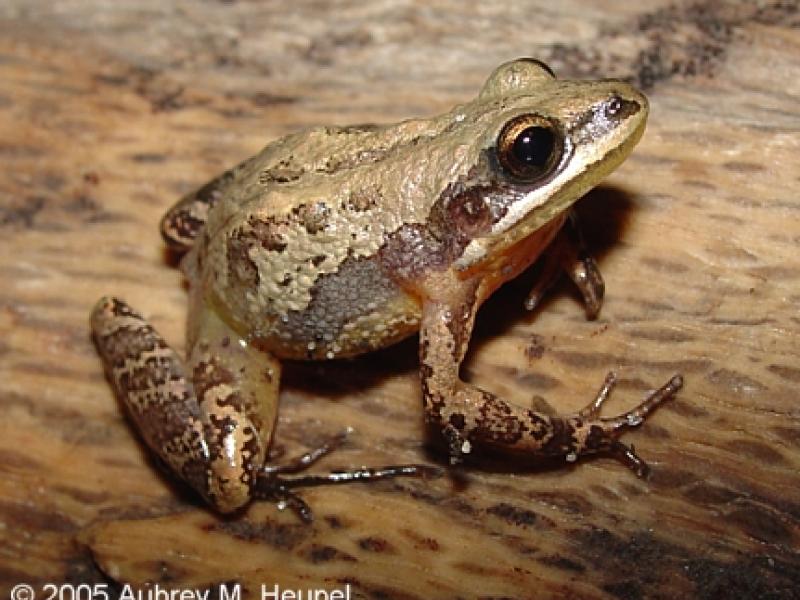Photo Credit: Robert Mount | Photo Credit: Aubrey M. Heupel
SCIENTIFIC NAME:
Pseudacris nigrita nigrita
STATUS:
Locally common in Dougherty Plain and Southern Pine Plains and Hills. Also occurs in eastern portion of Southern Hilly Gulf Coastal Plain. Lowest Conservation Concern.
DESCRIPTION:
A small, slender species reaching a maximum length of 1.3 inches. They typically have three dark stripes that are often broken into large spots down the back. This species has a pointed snout with a prominent white lip line. Above the lip line, a dark stripe runs from the nostrils through the eyes and along each side. The skin is covered in small, granular bumps, sometimes giving the species a warty appearance. The rear legs typically have dark bars, and the belly is yellowish.
DISTRIBUTION:
The southern chorus frog is another Coastal Plain species, ranging from North Carolina, south through Florida, and west into Mississippi. This species is restricted to the Lower Coastal Plain of Alabama, only extending northward in the area east of the Conecuh River.
HABITAT:
Southern chorus frogs inhabit the uplands of the Coastal Plain including sandhills and pine flatwoods. Preferred natural breeding habitats include grassy depressions, cypress ponds, and Carolina bays in, or near, areas of sandy soils. Man-made barrow pits, grassy ditches, and old field sites are also utilized. Little is known about what this species does outside of the breeding season, as they are rarely encountered after the breeding period. They likely spend most of their time in burrows or under debris in the surrounding uplands.
FEEDING HABITS:
Feeds primarily on small insects and other invertebrates.
LIFE HISTORY AND ECOLOGY:
Southern chorus frogs are most active during the winter months with the breeding season ranging from December through April. Although, calling males can sometimes be heard during or after heavy rain events (i.e. hurricanes) in the summer or fall. Males frequently begin calling during the day and continue until it becomes too cold at night. Males often advertise to females from clumps of grass, making them very difficult to locate. Their call is a slow trill that is sometimes compared to the sound of a ratchet. The number of pulses in each trill can usually be counted by ear whereas the trills of similar chorus frog species are too fast to count. Fun fact: The speed of the trill depends on temperature, so the lower the temperature, the slower the trill. Southern chorus frogs have been known to call in temperatures just above freezing, during which time their trills are extremely slow and drawn out!
Females lay eggs in clumps of 10-100, attaching them to the vegetation. The eggs hatch within a few days and will typically transform into froglets 6-8 weeks later. Tadpoles are brown with a transparent tail fin that is covered with small dark spots. A dark band extends onto the musculature of the tail. Tadpoles will reach a length of 1.5 inches before transforming.
References:
Dorcas, M. and Gibbons, W. 2008. Frogs & Toads of the Southeast. University of Georgia Press, Athens, GA. 238 pp.
Jensen, J. B., Camp, C. D., Gibbons, W., Elliott, M. J. 2008. Amphibians and Reptiles of Georgia. University of Georgia Press, Athens, GA. 575 pp.
Mount, Robert H. 1975. The Reptiles and Amphibians of Alabama. Auburn Printing Company, Alabama. 347 pp.
Author: Aubrey M. Heupel, Wildlife Biologist, Alabama Partners in Amphibian and Reptile Conservation







